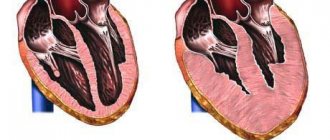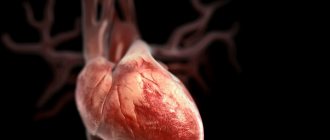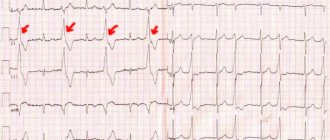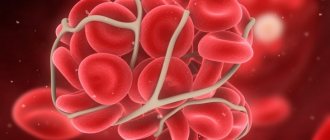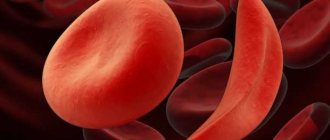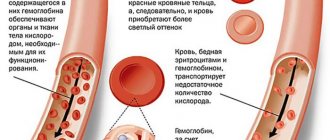The heart is the central organ of the circulatory system. Consists of three layers: endocardium, epicardium and myocardium. The inner mucous layer is the endocardium, the outside of the heart is fused with the pericardium, and the serous layer connects both parts - the epicardium. The main part is occupied by the middle muscle layer - the myocardium.
The myocardium is the thickest layer of the heart. The structural unit is the cardiomyocyte. The cells are able to transmit a kinetic charge, which determines the ability of the muscle to contract and relax.
The middle layer consists of universal cross-striated fibers twisted in the form of a spindle.
The tight connection of fibers allows the myocardium to relax and contract, that is, to eject blood from the organ cavity under pressure to provide nutrients and oxygen to organs and systems.
Connections or fibrous septa extend from the myocardium, dividing the heart into parts: 2 ventricles and 2 atria.
The middle layer of the heart has many functions:
- generation of an electrical impulse;
- carrying out excitation;
- contraction in response to irritation or excitement;
- ability to respond to impulses.
Several thousand liters of blood pass through the heart muscle per day.
Normally, the myocardium pumps biological fluid, but when pathological processes occur, blood circulation becomes difficult and diseases develop.
Metabolic processes
Metabolic changes in the myocardium, what is it? This is not a disease. This term is commonly understood as a complex of metabolic biochemical reactions inside cells. Disturbance of metabolic processes is expressed in the deviation of ECG segments from the isoline. Such processes can lead to disruption of the contractility of the heart muscle.
Metabolic disorders occur with the involvement of various biological substances:
- carbohydrates,
- proteins,
- electrolytes,
- enzymes,
- lipoproteins,
- vitamins
The main role is played by the balance of sodium, potassium, calcium and magnesium. Moderate metabolic changes in the myocardium develop against the background of improper regimen and lifestyle. After recovery they disappear. In medical practice, metabolic disorders (MD) are diagnosed with diseases such as:
- angina pectoris
- cardiomyopathy,
- hypertonic disease,
- myocardial dystrophy,
- heart disease.
These diseases require medical or surgical treatment.
Heart diseases associated with metabolic disorders
In cardiology, there are many heart diseases associated with metabolic disorders in the ventricular myocardium. One of the main diseases is angina pectoris.
It develops due to a mismatch between physical activity and blood flow in the myocardium. This happens when atherosclerotic plaques are deposited on the walls of the coronary arteries, blocking the vessel and leading to impaired blood flow.
Timely examination and treatment will prevent the development of a complication, the so-called myocardial infarction.
Other diseases associated with metabolic disorders in the myocardium are:
- hypertonic disease,
- vasculitis,
- rheumatism of the heart,
- myocardial dystrophy,
- arrhythmia,
- arterial hypertension.
Metabolic disorders in the myocardium are the result of diseases such as:
- beriberi,
- hypovitaminosis,
- obesity,
- acute pancreatitis,
- alcoholism,
- anemia,
- angina,
- caries.
Metabolism in the myocardium is disrupted due to severe hypothermia, overheating, disruption of the work and functioning of the kidneys, liver and pituitary gland. Long-term use of medications and various household poisons contribute to metabolic disorders in the myocardium.
Excessive exercise in athletes and disorders of protein metabolism can contribute to the formation of metabolic disorders in the heart.
Do not forget that if minor symptoms and metabolic disorders appear on the electrocardiogram, you should immediately go to the doctor. This is necessary for timely examination and treatment. Do not self-medicate, trust qualified professionals!
Causes and symptoms of MN
The cause of metabolic processes in the heart muscle can be:
- anemia,
- hypothermia or overheating of the body,
- psycho-emotional shock,
- excessive physical activity,
- kidney and liver diseases,
- intoxication of the body.
Excessive physical activity leads to dystrophic disorders of the posterior lower wall. Metabolic changes in the left ventricular myocardium are often observed in professional athletes.
Myocardial infarction is the most serious form of cardiac ischemia. This condition is characterized by a relative lack of blood supply to part of the myocardium, since the coronary artery is subject to thrombosis. Therefore, a necrotic focus is formed, and dead cardiomyocytes appear. Within the left-sided ventricle, the necrotic wall is most often found where there is a wall present anteriorly. Therefore, the presence of transmural myocardial infarction is most often determined in the anterior wall. More rarely, damage occurs to the apical region, the posterior wall, or the septum between the ventricles. Damage to the right ventricle by cardiology myocardium is not observed so often.
When there is a large infarction, in which more than fifty percent of the tissue in the myocardial wall behind is damaged, the organ does not function. Cardiogenic shock occurs. The patient dies. The disease is divided by localization. With a heart attack that is localized in the posterior lateral area, it moves in the left ventricle to the area of the lateral and posterior wall. The nephrotic area is localized where there is no proper function of the artery or vessel, in which cardiac region the appearance of acute oxygen starvation occurs.
The symptoms of MN depend on what was the underlying cause. However, there are a number of symptoms, the appearance of which indicates pathology in the heart muscle:
- heart rate disturbance,
- chest pain,
- drowsiness,
- dyspnea,
- pale skin.
Pronounced symptoms indicate progression of MN. If such symptoms appear, you should immediately consult a doctor.
Diagnosis of MN
The first place in diagnosing MR is given to the electrocardiogram. Metabolic changes in the myocardium on the ECG are noticeable already in the early stages of development. To make a diagnosis, a comprehensive analysis of the cardiogram is required. On the ECG, MN are determined in the form of deviations of segments and complexes from the isoline.
In the initial stages, deviations are noticeable only on the ECG; there may not be any unpleasant symptoms. In this case, metabolic disorders are determined during preventive examinations. If such a clinical picture was caused by temporary stress or physical overload, it is necessary to eliminate the irritant.
Myocardial metabolism is most often observed in the left ventricle. This is due to the fact that, due to the maximum functional load, it is more exposed to MR. Therefore, during an ECG, the doctor carefully analyzes the leads, segments and complexes that characterize the condition of the left ventricle.
Preventive actions
Manifestations of this nature require preventive action. The heart needs increased physical activity, proper nutrition and a well-designed regimen. In order for improvements to appear in the myocardium, it is necessary to spend time walking in the fresh air, and swimming is useful. In the event that changes are caused by chronic illnesses, you should not avoid consulting a doctor. The fact is that many people suffering from heart problems can only afford exercise therapy. Massage, wraps, and cryotherapy increase the chances of a favorable outcome. Some may benefit from myostimulation and hirudotherapy.
Types of MN
Myocardial changes are of two types:
- Diffuse.
- Dysmetabolic.
Diffuse changes occur against the background of existing inflammation (myocarditis). The cause may be excessive physical activity or taking certain medications. The diffuse type disrupts water-salt metabolism. Without treatment, this condition is dangerous for a person.
Dysmetabolic changes in the heart muscle indicate disturbances in physicochemical and biochemical processes in cells. Such changes are diagnosed in patients with angina pectoris and coronary artery disease. The reason is impaired blood circulation, due to which the heart muscle cells do not receive the required amount of oxygen and nutrients.
Cicatricial changes may occur in the myocardium. They occur during a heart attack with the development of a focus of necrosis. Often, scar variations occur in the posterior wall area.
Cardiopathy with aspiration syndrome
For aspiration syndrome
in newborns, against the background of ventilation-perfusion disorders in the lungs and hypoxemia, pulmonary vascular hypertension occurs, and the functional hemodynamic load increases, mainly on the right heart.
Diagnosis of cardiopathy
is carried out according to ultrasound examination of the heart and electrocardiography.
In this case, an echocardiogram
shows an increase in the diameter of the right ventricle and right atrium. A Dopplercardiogram reveals signs of high blood pressure at the mouth of the pulmonary artery.
Electrocardiographic picture
characterized by a sharp deviation of the EOS to the right, a high, pointed P wave in leads II, III, aVF, VI, a ventricular complex of type Rs or R in lead VI, type rS or rs in leads V5-V6 and a violation of the repolarization phase of the ventricular myocardium in the form of various changes T waves in the right precordial leads. The expansion of the cavity of the right atrium manifests itself in the form of an increase in the amplitude of the P wave in leads II, VI with a pointed apex.
After relief of aspiration syndrome
the functional state of the heart is restored and the described changes disappear.
Features of treatment
Treatment of metabolic changes in the myocardium involves taking drugs that affect metabolism in the heart muscle. Such drugs include:
- "Trimetazidine"
- "Inosine"
- "Mildronat".
"Trimetazidine" - supports the heart muscle during oxygen starvation, reduces damage to heart cells, normalizes contractility. The drug is available in tablet form. Tablets are taken twice a day - morning and evening. The course of treatment is prescribed by the doctor, taking into account the severity of the symptoms and the degree of damage. Possible side effects include nausea and vomiting. Tablets are contraindicated for children under 18 years of age.
“Inosine” - reduces the severity of MN symptoms, has a beneficial effect on blood supply, gas exchange processes, and normalizes blood clotting. Depending on the degree of damage, the drug is prescribed for oral administration or as intravenous injection. In case of individual intolerance, an allergy may occur.
"Mildronate" - regulates oxygen exchange and has detoxifying properties, and also has a positive effect on cerebral and coronary circulation. Take the drug orally twice a day. Side effects: insomnia, nausea, vomiting, increased heart rate, allergies.
Medicines
Two groups of drugs are used:
- acting on cardiomyocytes by regulating hormonal balance and nerve impulses;
- improving the internal composition and compensating the energy needs of cells.
The drugs of the first group include: hormonal drugs, drugs acting on the nervous system.
The second group includes: enzymatic agents, vitamins, drugs that affect protein, lipid and carbohydrate metabolism.
- For complete therapy, a vitamin complex of B1, B2, pantothenic and lipoic acids is prescribed. They must be used together, since only in this composition does the effect on metabolism occur.
- To eliminate the influence of free radicals, antioxidants are used: vitamins E and PP (nicotinic acid).
- It is possible that the patient does not digest protein well even with sufficient amounts in food. For improvement, anabolic steroids are prescribed for a short course.
- It is recommended to replenish the supply of intracellular potassium with Panangin, Asparkam, Potassium Orotate (orotic acid is involved in protein synthesis).
- Tinctures of ginseng, eleutherococcus, aralia, rhodiola, and lemongrass have a good effect on regulatory processes. They help the heart muscle adapt to lack of nutrition.
- A group of nootropics (Piracetam) restores nervous regulation and enhances reparative processes in the myocardium.
Consequences of MN
Pathological processes in the heart muscle lead to oxygen starvation and accumulation of lactic acid. Inside the muscle cells of the heart, sodium levels increase and potassium and glycogen levels decrease. Without treatment, MN leads to morphological abnormalities.
The nature of the course of morphological processes has 2 types:
- The transverse striation disappears in the affected areas, the nuclei in the cells remain. This type is harmless and passes quickly,
- the transverse striation of myofibrils disappears, the nuclei in the cells are destroyed, and necrosis develops.
MN increase the risk of developing cardiomyopathy and myocardial dystrophy. Cardiomyopathy is a severe heart pathology that causes heart failure. The prognosis for the patient is unfavorable. Myocardial dystrophy causes dystrophic processes in cardiomyocytes. The contractile function of the heart decreases.
